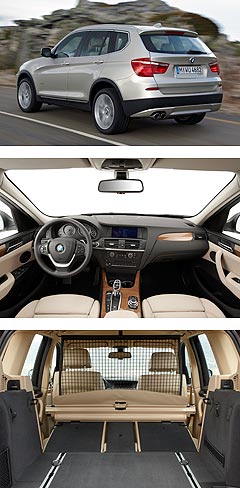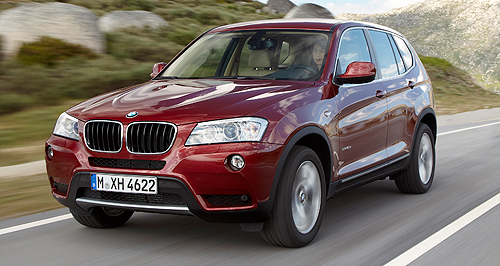Future models - BMW - X3First look: BMW lets all-new X3 looseBigger: BMW's new X3 SUV has grown to make room for the X1. Second-generation BMW X3 compact SUV emerges ahead of Paris motor show15 Jul 2010 By TERRY MARTIN BMW has taken the wraps off a larger, more sharply styled and thoroughly re-engineered second-generation X3 ahead of its world debut at the Paris motor show in September and its launch in Australia early in 2011. Although teaser shots planted on the German manufacturer’s Dutch website in May indicated that the new-generation X3 would be evolutionary in design, the small luxury SUV has emerged with highly creased bodywork that draws heavily from the smaller X1. BMW describes the design as a “dynamically stretched silhouette” that retains the character of its X models, which in the case of the new X3 sees its dimensions move closer to the X5 in order to distance itself from X1. “Yes, it is a larger car with wider appeal,” said BMW Group Australia spokesman Piers Scott, who confirmed to GoAuto that timing for a local launch would be at the tail end of the first quarter of 2011, at the earliest. “Both X5 and X3 have grown to make room for X1. This is now one of the more competitive segments and this car has the ability to attract customers from other brands that may not have looked at the previous model.” Squeezed by new rivals such as Audi’s Q5, the current X3 is down 10 per cent sales-wise in Australia after the first half of 2010 – to sit at 530 units – after a 5.4 per cent increase in 2009, to 1300 units.  Q5 sales, by comparison, are up 150 per cent this year, with Audi selling more vehicles in the first half (1346) than BMW managed for the entire 12 months last year with X3. Q5 sales, by comparison, are up 150 per cent this year, with Audi selling more vehicles in the first half (1346) than BMW managed for the entire 12 months last year with X3.Although the new-generation X3 certainly looks longer, the changes are not, however, as substantial as expected, with overall length increasing just 79mm to 4648mm and width expanding 28mm to 1881mm, while the overall height falls slightly (13mm) to 1661mm. The wheelbase has extended 15mm to 2795mm, assisting BMW to increase luggage capacity by 70 litres with the 60/40-split (or optional 40/20/40) rear seats upright – now at 550 litres – and to achieve a new maximum load volume of 1600 litres, which is up 40 litres on the current version and is now claimed to be the best in its class. The rear passenger compartment is also claimed to now offer “significantly more leg and elbow room” compared to the current model, although specific details are still to be divulged, while BMW also looks to have answered criticism of the first-generation X3’s cabin in improving the quality feel. In an effort to create a “modern, premium ambience with intelligent functionality”, the X3 cabin now carries higher-grade materials, a redesigned instrument panel (set more horizontally to accentuate the extra width), a more asymmetrical centre console, a large optional 8.8-inch onboard monitor (up from the standard 6.5-inch unit) and more storage facilities. Although the Australian model range is still to be confirmed, the X3’s equipment levels have increased and improvements made across the board in areas such as chassis and powertrain development. BMW Australia advises that additions to the engine line-up are expected by the time the local launch rolls around, although the petrol and diesel engines announced overnight demonstrate that the new X3 will offer higher performance, better economy and advanced technology, including the ZF-engineered eight-speed automatic – as seen in the updated X5 launched here this month – and idle-stop and brake energy regeneration (BEG) systems. The headline act is the xDrive35i variant, which features BMW’s 3.0-litre direct-injection turbocharged inline-six petrol engine, producing 225kW at 5800rpm and 400Nm from just 1300rpm, and enabling the similarly weighted new-generation model – in this case, tipping the scales at 1880kg – to accelerate from 0-100km/h in just 5.7 seconds. Maximum speed is limited to 245km/h. The eight-speed ZF self-shifter is fitted standard to the 35i and marks the first application of idle-stop with an automatic and a BMW straight-six engine. The xDrive permanent four-wheel drive system – upgraded for the new model – remains a constant across the range, although two-wheel drive variants are expected further down the track. Average fuel consumption for the xDrive35i comes in at an impressive 8.8L/100km – a considerable improvement, for example, over the current range-topping 200kW/315Nm xDrive30i 3.0-litre six (9.7L/100km) – while CO2 emissions tumble to 204g/km. At the other end of the scale, the entry xDrive 20d 2.0-litre turbo-diesel variant improves on the 130kW/350Nm offered in the current model with outputs of 135kW at 4000rpm and 380Nm from 1750-2750rpm and better all-round performance. Acceleration from 0-100km reduces to 8.5 seconds with either a six-speed manual or the ZF eight-speed automatic, while fuel consumption is a frugal 5.6L/100km for either transmission. CO2 emissions are 149g/km for the manual, or 147 for the auto – said to be the lowest emissions in its class. Top speed is 210km/h. Other engines expected to arrive at launch include a twin-turbocharged diesel and a mid-range naturally aspirated 3.0-litre six-cylinder petrol. As well as idle-stop and BEG, the improved environmental performance is, according to BMW, the result of new lightweight components, fitment of low-rolling resistance tyres, use of “demand-controlled” ancillary components and the introduction of an electric power steering (EPS) system. The latter includes a Servotronic function for speed-dependent power steering, while BMW has also developed an optionally available “variable sports steering” system designed to reduce the degree of steering movement necessary, which in turn requires less steering effort for parking, cornering and swerving manoeuvres. The turning circle is up slightly to 11.9m, the fuel tank capacity remains at 67 litres and ground clearance climbs a little higher to a useful 212mm. This is the first time an X-rated model from BMW has taken on EPS, and is also the first to offer Variable Damper Control (VDC). The latter will be available as an option and includes a ‘dynamic control system’ which allows the driver to choose between Normal, Sport and Sport+ modes. As well as damping behaviour, VDC has been developed to adjust other driving characteristics, including the accelerator, engine response, power steering weight, ESC response thresholds and the shifting dynamics of the automatic gearbox. Other chassis changes include a “completely redeveloped” suspension that sticks with a double-joint spring-strut axle at the front and combines this with a multi-link (ie, five-link) rear end. The front/rear track has also increased over the current model, now at 1594/1610mm (xDrive35i) and 1616/1632mm (xDrive20d) respectively compared to the current X3’s 1524/1542mm (and current 20d’s 1538/1556mm). Standard braking hardware includes 328/330mm front/rear ventilated disc brakes, all gripped by single-piston callipers. The xDrive35i runs on 18-inch alloy wheels with 245/50-section tyres, while the 20d uses 17-inch rims and 225/60 rubber. Other standard items include ESC, traction control, Cornering Brake Control (CBC), Dynamic Brake Control (DBC), ‘rain brake support’, hill-start assist, ‘adaptive brake compensation’, hill-descent control and ABS brakes. Passive safety features par for the course include dual front and front-side airbags, front and rear head airbags, and anti-whiplash front head restraints. A range of BMW ConnectedDrive options has also been developed for the new-generation X3, such as a head-up display, internet access and a reversing camera with ‘top view’. Other optional items of note include high-end stereos, automatic tailgate operation, a panoramic sunroof, adaptive cornering headlights and a tow coupling with electronically pivoting tow ball. Production will switch from Europe to BMW’s Spartanburg plant in the US, where it already produces the X5 and X6.  Read moreAll future models Alfa Romeo Alfa Romeo Abarth Abarth Audi Audi Aston Martin Aston Martin BMW BMW Bentley Bentley Chrysler Chrysler Chevrolet Chevrolet Dodge Dodge Citroen Citroen Ferrari Ferrari DS DS Ford Ford Fiat Fiat FPV FPV Foton Foton Haval Haval Great Wall Great Wall Honda Honda Holden Holden Hyundai Hyundai HSV HSV Isuzu Isuzu Infiniti Infiniti Jeep Jeep Jaguar Jaguar Lamborghini Lamborghini Kia Kia Lexus Lexus Land Rover Land Rover Mazda Mazda Maserati Maserati Mercedes-Benz Mercedes-Benz McLaren McLaren Mini Mini Nissan Nissan Mitsubishi Mitsubishi Peugeot Peugeot Opel Opel Proton Proton Porsche Porsche Renault Renault Ram Ram Saab Saab Rolls-Royce Rolls-Royce Smart Smart Skoda Skoda Subaru Subaru SsangYong SsangYong Tesla Tesla Suzuki Suzuki Toyota Toyota Volvo VolvoX3 pricing
Motor industry news |
Click to shareBMW modelsResearch BMW All future models Alfa Romeo Alfa Romeo Abarth Abarth Audi Audi Aston Martin Aston Martin BMW BMW Bentley Bentley Chrysler Chrysler Chevrolet Chevrolet Dodge Dodge Citroen Citroen Ferrari Ferrari DS DS Ford Ford Fiat Fiat FPV FPV Foton Foton Haval Haval Great Wall Great Wall Honda Honda Holden Holden Hyundai Hyundai HSV HSV Isuzu Isuzu Infiniti Infiniti Jeep Jeep Jaguar Jaguar Lamborghini Lamborghini Kia Kia Lexus Lexus Land Rover Land Rover Mazda Mazda Maserati Maserati Mercedes-Benz Mercedes-Benz McLaren McLaren Mini Mini Nissan Nissan Mitsubishi Mitsubishi Peugeot Peugeot Opel Opel Proton Proton Porsche Porsche Renault Renault Ram Ram Saab Saab Rolls-Royce Rolls-Royce Smart Smart Skoda Skoda Subaru Subaru SsangYong SsangYong Tesla Tesla Suzuki Suzuki Toyota Toyota Volvo VolvoX3 pricing
Motor industry news |















Facebook Twitter Instagram